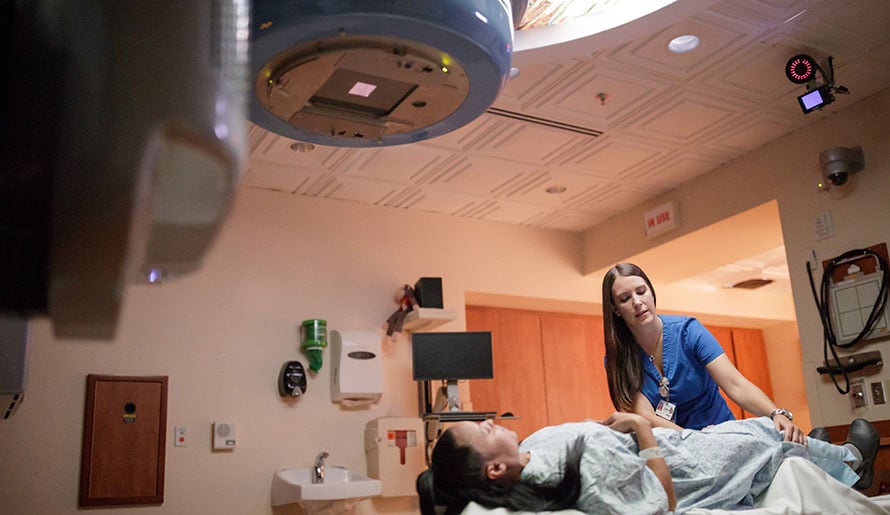Adaptive Radiotherapy

Since its conception in the late 1990s, adaptive radiotherapy has emerged as a promising new form of cancer treatment. Below, Moffitt Cancer Center explains what adaptive radiotherapy is, the benefits it offers, how it’s administered and the types of cancer it can potentially be used to treat.
What is adaptive radiotherapy?
Before discussing adaptive radiotherapy’s definition, it may be helpful to explain what radiation therapy itself is. Radiation therapy is a type of cancer treatment that uses high doses of radiation (administered either externally or internally) to shrink tumors, destroy cancer cells, relieve symptoms and in many cases completely eliminate the cancer. This treatment is typically administered multiple times over the course of several days or weeks. Once the cancer cells’ DNA is sufficiently damaged, the patient stops receiving radiation therapy. Then, the cancer cells continue to die over the following weeks or months.
So, what is adaptive radiotherapy? Adaptive radiotherapy (also referred to as "adaptive radiation therapy") is a type of radiation therapy that involves continually adjusting treatment to account for changes taking place within the patient's body, with the goal of administering the most accurate radiation dosage possible. As noted above, radiation therapy often takes several days or weeks to complete, and certain anatomical and physiological changes can occur during that time, whether due to treatment itself or other factors. These changes may involve:
- The size, shape or location of the tumor
- The size, shape or location of nearby organs
- Weight loss
Even a minor change can necessitate an adjustment to the dosage of radiation. For example, in the context of treating bladder cancer, drinking too much or too little liquid prior to radiation therapy could impact bladder volume, which could in turn require an adjustment.
What are the benefits of adaptive radiotherapy?
As was explained above, the goal of adaptive radiotherapy is to administer the most accurate dose of radiation possible based on any changes within the tumor itself or the surrounding area of the patient’s body. By doing so, specialists can:
- More effectively target tumors
- Reduce how much normal, healthy tissue is exposed to radiation during treatment
- Minimize any resulting side effects
How is adaptive radiotherapy administered?
Before beginning a course of radiation therapy, a patient will undergo a series of imaging scans (for example, CT scans, MRI scans or X-rays). Specialists will use the resulting images (known as “planning images”) to plan the patient’s course of treatment.
With adaptive radiotherapy, the patient will also undergo another set of scans immediately before or during each radiation therapy session. Specialists will compare the resulting images to ones that were previously taken to determine whether there have been any changes, and if so, they will adjust the radiation dose accordingly.
What types of cancer can adaptive radiotherapy be used to treat?
The clinical implementation of adaptive radiotherapy is a relatively new development in the fight against cancer, and as such, researchers are still working to determine how and when it should be used. With that being said, studies suggest that adaptive radiotherapy shows promise for treating a variety of malignancies, including:
Moffitt's approach to adaptive radiotherapy
As one of the nation’s leading cancer treatment centers, Moffitt Cancer Center consistently remains at the forefront of developments affecting the prevention, detection, diagnosis and treatment of cancer, and adaptive radiotherapy is no exception. We're pleased to make this innovative cancer treatment available to our patients using our state-of-the-art Magnetic Resonance Imaging Guided Linear Accelerator (MRI-LINAC) technology. The MRI-LINAC combines two instruments—an MRI scanner for imaging and a linear accelerator to radiate—into one device, allowing us to view high-definition, diagnostic-quality images of a tumor while simultaneously targeting it with high-energy radiation beams. Viewing real-time images enables specialists to keep the beams precisely focused on the tumor throughout the entire radiation therapy session, making adjustments as needed whenever the tumor shifts (for example, when the patient breathes in and out).
Medically reviewed by Dr. Eduardo G. Moros
If you'd like to know more about adaptive radiotherapy, the many benefits it offers for cancer patients and how it's being used at Moffitt Cancer Center, please contact us. You can call us at 1-888-663-3488 or fill out our new patient registration form online—referrals are not required. At Moffitt, we understand that every day counts after receiving a cancer diagnosis, so we've made it our goal to disrupt the traditional care model and provide patients with rapid access to the treatments they need. When you reach out to us, we’ll connect you to a cancer expert as soon as possible.
References
National Cancer Institute: Radiation Therapy to Treat Cancer
ScienceDirect: Adaptive Radiotherapy
Radiation Therapy
- 3D CRT (Three-Dimensional Conformal Radiation Therapy)
- Adaptive Radiotherapy
- APBI (Accelerated Partial Breast Irradiation)
- Brachytherapy
- Common Questions
- CT-Driven Virtual Simulations
- External Radiotherapy
- IGRT (Image Guided Radiation Therapy)
- IMRT (Intensity Modulated Radiation Therapy)
- Internal Radiotherapy
- INTRABEAM® Intraoperative Radiotherapy
- Linear Accelerator (LINAC)
- MRI-Linac
- On-Board Imaging (OBI)
- Radiopharmaceuticals
- Residency Program
- Respiratory Gating
- SBRT (Stereotactic Body Radiation Therapy)
- Stereotactic Radiosurgery
- Total Body Irradiation (TBI)
- Total Skin Electron Therapy (TSET)
- Volumetric Modulated Arc Therapy (VMAT)
